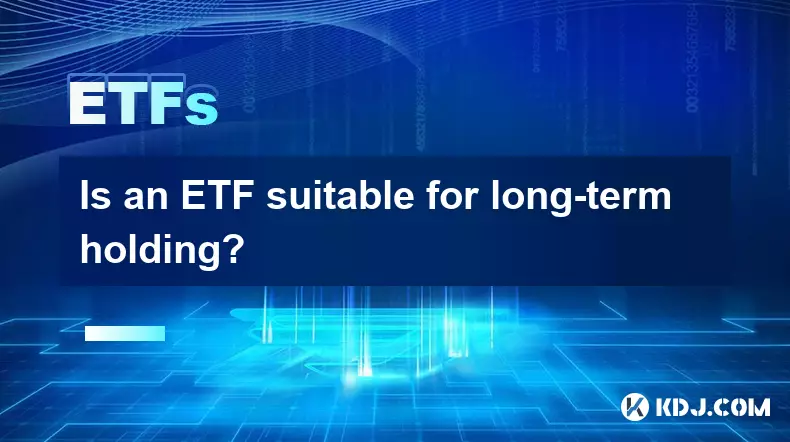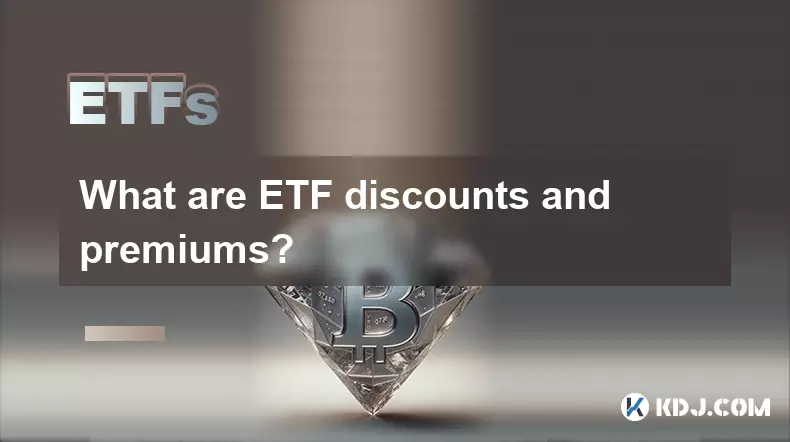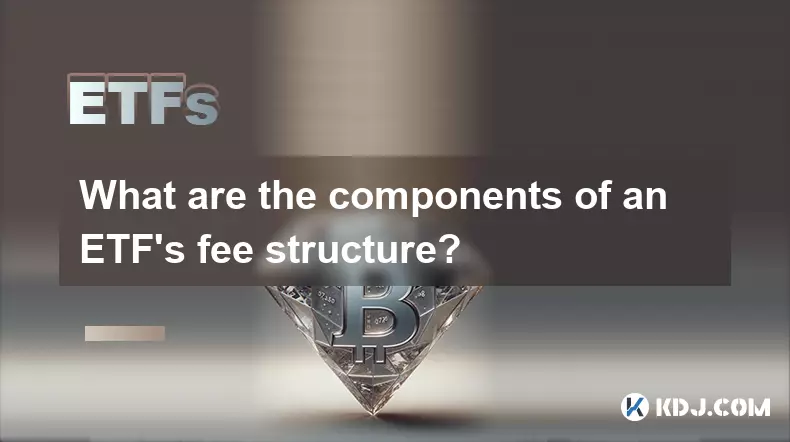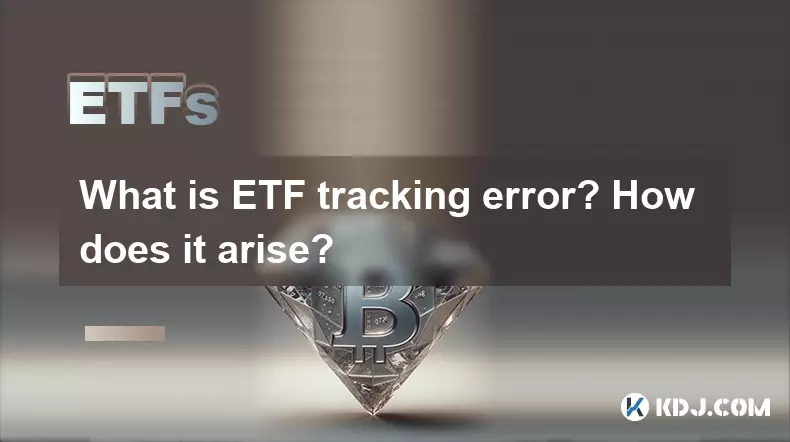-
 bitcoin
bitcoin $107015.826941 USD
-2.18% -
 ethereum
ethereum $3637.352324 USD
-5.18% -
 tether
tether $0.999831 USD
-0.02% -
 xrp
xrp $2.338078 USD
-6.23% -
 bnb
bnb $998.272150 USD
-6.97% -
 solana
solana $167.598257 USD
-10.12% -
 usd-coin
usd-coin $0.999863 USD
0.01% -
 tron
tron $0.282573 USD
-5.09% -
 dogecoin
dogecoin $0.169891 USD
-7.39% -
 cardano
cardano $0.557554 USD
-7.03% -
 hyperliquid
hyperliquid $39.914802 USD
-5.85% -
 chainlink
chainlink $15.414549 USD
-9.97% -
 bitcoin-cash
bitcoin-cash $510.361911 USD
-4.26% -
 ethena-usde
ethena-usde $0.999194 USD
-0.03% -
 stellar
stellar $0.282092 USD
-6.07%
ETF Investing Primer: What are exchange-traded funds?
Crypto ETFs offer regulated, secure exposure to digital assets through traditional markets, simplifying investment without direct ownership of cryptocurrencies.
Sep 21, 2025 at 01:00 pm

Understanding Exchange-Traded Funds in the Cryptocurrency Space
1. Exchange-traded funds (ETFs) have become a bridge between traditional financial instruments and the rapidly evolving cryptocurrency market. These investment vehicles allow investors to gain exposure to digital assets without directly owning them. By pooling capital from multiple investors, crypto ETFs purchase and hold underlying assets such as Bitcoin or Ethereum, issuing shares that trade on regulated stock exchanges.
2. Unlike buying and storing cryptocurrencies on a digital wallet, investing in a crypto ETF simplifies access for retail and institutional players alike. The structure provides built-in regulatory oversight, custody solutions, and liquidity, reducing some of the operational burdens associated with direct ownership. This accessibility has contributed to wider adoption among risk-averse participants who still want exposure to blockchain-based assets.
3. The mechanics of crypto ETFs mirror those of traditional ETFs. They are priced continuously throughout the trading day, allowing investors to buy and sell shares in real time. Premiums or discounts to the net asset value (NAV) can occur based on market demand, but arbitrage mechanisms typically keep prices aligned with the underlying holdings.
4. Regulatory approval plays a critical role in the launch and sustainability of cryptocurrency ETFs. Jurisdictions like the United States require rigorous scrutiny from bodies such as the Securities and Exchange Commission (SEC). Approval signals legitimacy and can trigger increased inflows from conservative investors wary of unregulated markets.
5. As more countries explore frameworks for digital asset regulation, the global footprint of crypto ETFs is expanding. Canada, Brazil, and several European nations have already authorized spot Bitcoin ETFs, creating competitive pressure on larger markets to follow suit. This cross-border development fosters innovation while testing compliance standards across different legal systems.
The Role of Custody and Security in Crypto ETFs
1. One of the primary advantages of a cryptocurrency ETF is the professional custody of digital assets. Instead of individuals managing private keys, licensed custodians secure the underlying coins using cold storage, multi-signature protocols, and insurance coverage. This reduces the risk of theft, loss, or technical failure common in self-custody scenarios.
2. Institutional-grade security measures ensure that the assets backing the ETF remain intact and verifiable. Regular audits and proof-of-reserves reports provide transparency, reinforcing investor confidence. These safeguards are especially important given the irreversible nature of blockchain transactions.
3. Custodial arrangements also help mitigate counterparty risk. Reputable firms often partner with established financial institutions or specialized crypto custodians like Coinbase Custody or BitGo, which adhere to strict compliance protocols including AML and KYC standards.
4. The integration of robust custody solutions enables traditional brokerage platforms to offer crypto ETFs alongside conventional securities. Investors can access these products through familiar interfaces without needing separate accounts on cryptocurrency exchanges.
5. In cases where an ETF holds derivatives rather than physical assets, custodianship extends to monitoring contract performance and settlement processes. While this introduces additional layers of complexity, it also allows for hedging strategies and leverage within regulated boundaries.
Market Impact and Investor Behavior Trends
1. The introduction of cryptocurrency ETFs has influenced market dynamics by channeling institutional capital into digital assets. Large fund managers and pension funds that were previously restricted from direct crypto investments now participate indirectly through ETF vehicles.
2. Trading volumes in crypto ETFs often reflect broader sentiment in the market. Sudden spikes in inflows may precede price rallies, while sustained outflows can signal bearish outlooks. Analysts monitor these patterns closely as leading indicators of macro-level shifts.
3. Retail investors benefit from lower entry barriers and reduced volatility exposure when investing in diversified crypto ETFs. Instead of concentrating risk on a single coin, they gain proportional stakes in baskets that may include various altcoins or blockchain-related equities.
4. Fee structures vary significantly across providers, influencing investor choices. Some ETFs charge management fees under 1%, while others exceed 2%. Expense ratios directly impact long-term returns, making cost-efficiency a key consideration during selection.
5. Tax treatment of crypto ETFs differs by jurisdiction but generally aligns with equity-like instruments rather than commodity holdings. This classification can lead to more favorable capital gains rates compared to direct crypto sales, enhancing after-tax performance for certain investors.
Frequently Asked Questions
What distinguishes a spot crypto ETF from a futures-based ETF?A spot crypto ETF holds actual digital currencies as its underlying assets, providing direct exposure to price movements. In contrast, a futures-based ETF invests in cryptocurrency futures contracts, which derive value from expected future prices and may exhibit tracking errors due to contango or backwardation effects.
Can investors redeem ETF shares for the underlying cryptocurrency?No, typical crypto ETF structures do not allow individual investors to exchange shares for physical coins. Redemption occurs at the institutional level through authorized participants who settle in cash or securities, maintaining the closed-loop system of the fund.
Are all crypto ETFs backed 1:1 by real assets?Reputable crypto ETFs maintain full backing of their shares with equivalent reserves of digital assets or legally enforceable claims. However, verification depends on audit disclosures and regulatory oversight. Investors should review fund documentation to confirm asset backing and custodial arrangements.
How does taxation work for gains from crypto ETFs?In most regions, profits from selling crypto ETF shares are treated as capital gains, similar to stocks. The tax rate depends on holding period and local laws. Since the ETF itself handles the crypto holdings, investors avoid direct reporting obligations related to wallet transfers or on-chain activity.
Disclaimer:info@kdj.com
The information provided is not trading advice. kdj.com does not assume any responsibility for any investments made based on the information provided in this article. Cryptocurrencies are highly volatile and it is highly recommended that you invest with caution after thorough research!
If you believe that the content used on this website infringes your copyright, please contact us immediately (info@kdj.com) and we will delete it promptly.
- MEXC, USDf, and Trading Volume: A Deep Dive into Recent Developments
- 2025-11-04 19:15:01
- Bitcoin, Crypto, and EcoYield Bonus: Is This the Smartest Play Now?
- 2025-11-04 19:15:12
- Cardano (ADA) and Altcoin Growth: Navigating the Landscape
- 2025-11-04 19:15:12
- XRP ETF Buzz: Is a Price Surge on the Horizon?
- 2025-11-04 19:20:01
- Milk Mocha's $HUGS: The Presale Meme Coin Redefining Community and Value
- 2025-11-04 17:50:02
- Dogecoin, Lyno AI, and Growth Potential: A New Era for Crypto?
- 2025-11-04 17:45:01
Related knowledge

Is an ETF suitable for long-term holding?
Oct 01,2025 at 02:36am
Understanding ETFs in the Context of Cryptocurrency Investments1. Exchange-traded funds (ETFs) have gained significant traction in traditional financi...

What are ETF discounts and premiums?
Sep 29,2025 at 11:19pm
Understanding ETF Discounts and Premiums1. Exchange-traded funds (ETFs) are investment vehicles that trade on stock exchanges, much like individual st...

How do I evaluate an ETF?
Sep 22,2025 at 11:18am
Evaluating the Fundamentals of an ETF1. Examine the underlying index the ETF tracks to understand its investment focus. Whether it follows a broad mar...

What are the components of an ETF's fee structure?
Sep 30,2025 at 03:54am
Management Fees in ETFs1. Management fees, often referred to as the expense ratio, represent the primary cost investors pay for the operation of an ET...

What is ETF tracking error? How does it arise?
Sep 20,2025 at 03:18am
Understanding ETF Tracking Error in the Cryptocurrency Market1. Exchange-traded funds (ETFs) have become a significant bridge between traditional fina...

What factors determine ETF liquidity?
Sep 26,2025 at 05:00pm
Understanding ETF Liquidity Drivers1. The underlying assets of an ETF play a crucial role in determining its liquidity. When the securities within the...

Is an ETF suitable for long-term holding?
Oct 01,2025 at 02:36am
Understanding ETFs in the Context of Cryptocurrency Investments1. Exchange-traded funds (ETFs) have gained significant traction in traditional financi...

What are ETF discounts and premiums?
Sep 29,2025 at 11:19pm
Understanding ETF Discounts and Premiums1. Exchange-traded funds (ETFs) are investment vehicles that trade on stock exchanges, much like individual st...

How do I evaluate an ETF?
Sep 22,2025 at 11:18am
Evaluating the Fundamentals of an ETF1. Examine the underlying index the ETF tracks to understand its investment focus. Whether it follows a broad mar...

What are the components of an ETF's fee structure?
Sep 30,2025 at 03:54am
Management Fees in ETFs1. Management fees, often referred to as the expense ratio, represent the primary cost investors pay for the operation of an ET...

What is ETF tracking error? How does it arise?
Sep 20,2025 at 03:18am
Understanding ETF Tracking Error in the Cryptocurrency Market1. Exchange-traded funds (ETFs) have become a significant bridge between traditional fina...

What factors determine ETF liquidity?
Sep 26,2025 at 05:00pm
Understanding ETF Liquidity Drivers1. The underlying assets of an ETF play a crucial role in determining its liquidity. When the securities within the...
See all articles










































































